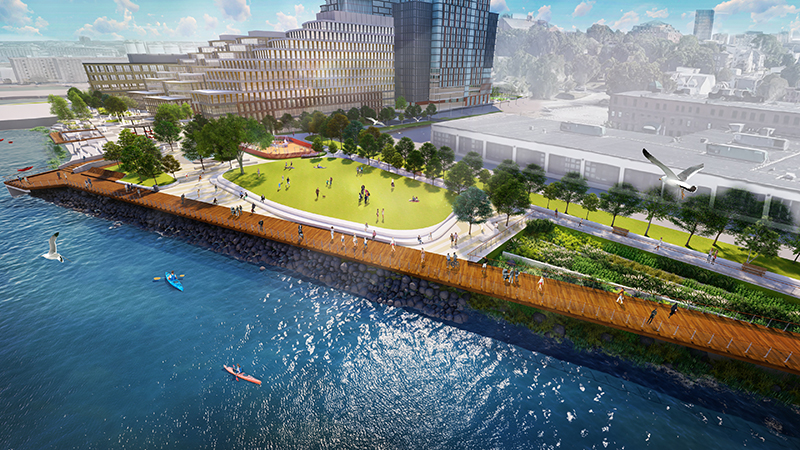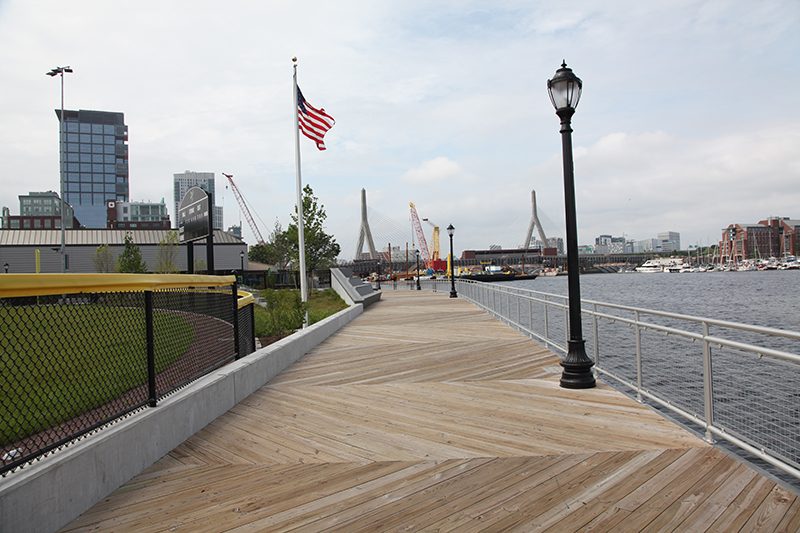
Weston Sampson



As the impacts of climate change-driven sea level rise, urban heat island effect, and intensifying storms become more apparent and more severe, the first lines of defense in many coastal cities like Boston are our waterfront parks and other open spaces. The demand for waterfront real estate is on the rise, which means there are opportunities for thoughtful design that creates both a resilient landscape and equitable access to the waterfront.
Waterfront parks can provide critical flood protection by integrating barriers and other innovative green stormwater management solutions into the landscape that double to relieve heat effects. Well-designed and strategically placed parks at the land/water interface can also contribute to regional initiatives and protect our cities and towns. Open space has significant benefits for public health and serve as social hubs for communities and because of this ability to impact the environment and public wellness, it is time we started thinking of parks as critical infrastructure, just like our water, sewer, and electrical infrastructure.
Design and engineering firms like Weston & Sampson, along with many forward-thinking municipalities and property owners, are at the forefront of advocating for our waterfront open spaces as critical infrastructure in the Boston area and elsewhere. For the following waterfront parks, climate resilience and sea level rise were central to the design strategy.

In Charlestown, The Flatley Company is in the process of developing the Schrafft’s Campus, a 55-acre former Domino Sugar refinery site on the Mystic River, into a mixed-use development. It will address existing and future flooding from sea level rise by incorporating a resilient flood barrier within a system of new public open spaces. The site enhancements also emphasize green infrastructure for both stormwater and urban heat mitigation, accomplished in conjunction with the creation of new, multi-level, public pedestrian open spaces. This new waterfront urban park will also provide regional flood protection for over 220 acres of Charlestown and parts of Somerville and Cambridge.
The harborfront Langone Park and Puopolo Playground in the North End recently received a comprehensive climate-resilient renewal. The Weston & Sampson team designed a barrier inland of the existing seawall that is integrated into the park through seating elements along the elevated boardwalk. Sections of the park were raised using ground improvement techniques and lightweight soils up to seven feet to reduce future flooding impacts. Stormwater and infrastructure protection strategies enable a faster recovery of the park and neighborhood after coastal and extreme storm events.

McConnell Park in Dorchester sits in a low-lying area adjacent to the Dorchester Bay Basin where stormwater from the surrounding neighborhood streets, coupled with tides that backflow up through storm drain system, creates intense and prolonged flooding during major storm events. The site will be regraded to elevate parts of the park to reduce the frequency of flooding and recover quickly after flood events. Backflow prevention devices were added to existing stormwater outfalls to prevent inundation through infrastructure. These renovations will protect capital investments within the park property and surrounding residences and will accommodate both stormwater and coastal flooding in intentionally designed areas.
On the other side of Boston Harbor, at LoPresti Park in East Boston, the goal is to design a contemporary park that links the Maverick Gardens neighborhood to the water and strengthens pedestrian connections to the surrounding community. LoPresti functions as an intensely used neighborhood park and playground and recent improvements provide several active recreational amenities, including a synthetic turf field, kayak ramp, and new basketball courts. Raising various elements of the park reduces tidal flood risk now and in the future.
Prescott Park is a 10-acre park in Portsmouth, New Hampshire that sits on 1,150 feet of Piscataqua River frontage. Hosting hundreds of thousands of visitors annually, the park is the low point in the neighborhood and its immediate neighbors, including the historic Strawbery Banke, are prone to stormwater and coastal flooding. Planned resilient upgrades to the park include protecting the park along its seawall edge by installing tide gates and raising the sea wall. Critical historic and other infrastructure will be moved to higher ground by raising and shifting a significant building to a higher elevation, and flooding will be accommodated by regrading the central lawn to hold 300,000 gallons of stored water during peak storm events.
The rehabilitation of Moakley Park in South Boston is an opportunity to address climate vulnerabilities and advance resilience along the waterfront while improving opportunities for recreation and gathering. The 2018 Moakley Park Vision Plan, developed by Stoss Landscape Urbanism, presented concepts like the creation of a flood barrier. A key task to move the project forward was analyzing current and future climate risks while accounting for shallow groundwater, subsurface utilities, and poor soil conditions. With a resilient design strategy for flood mitigation, improved layout, and revitalized amenities, the park’s resilience to sea level rise and other climate events will be greatly improved and it will provide a range of recreational opportunities for a diverse, multi-generational population.
If 2020 taught us anything, it is that properly functioning parks are essential to our health and wellbeing as a society. We invite you to help us celebrate those real estate owners and municipalities that are treating their parks and open spaces like they treat their water, sewer, and electricity systems - as critical infrastructure.
Cheri Ruane, FASLA is a vice president and Julie Eaton Ernst, PE is lead resiliency engineer with Weston & Sampson, Reading, Mass.